The gauge registered 1.76 metres after persistent rain.
18
October 2012
The
gauge registered 1.76 metres, the highest I have
ever recorded by 10 cm, after
the high tides and storm surge.
Widewater: SALINITY PAGE
Widewater is a landlocked brackish lagoon approximately 1066 metres long and 90 metres at its widest point when the lagoon is in flood. It was created by Man from the original Adur estuary after been landlocked by longshore drift and violent storms. The waters are replenished by the sea, which filters up through the basin of the lagoon on very high tides, and also by rain water. There is a dramatic rise in the level after heavy rainfall, more than can be explained by the rain landing directly on the lagoon flood plain. Man has built up banks on the perimeter of the lagoon to prevent flooding to this nearby reclaimed land, now turned to residential use. The quantity of water contained within the lagoon and salinity are liable to fluctuate wildly. The flood plain covers an area of 18.5 acres.At its maximum flooding with a measurement on the gauge by the bridge giving a depth of 1.60 metres, the lagoon will cover an area of 4.6 hectares (=11.4 acres) with a perimeter of 2282 metres.
by Steve Barker and Andy Horton
| 17
December 2012
The gauge registered 1.76 metres after persistent rain. 18
October 2012
|
| 7
October 2010
The gauge registered 1.65 metres, the highest I have ever recorded, |
| 19
February 2007
The flooded Widewater Lagoon registered 1.64 metres on the gauge by the bridge, as high as the lagoon gets after the spring tides and recent rain, with the pipeline fully open. |
 |
 |
12
September 2006
The
flooded lagoon registered 1.64 metres on the gauge by the bridge, as high
as the lagoon gets after the spring tides of the last few days.
7 November
2005
There
were at least eleven Cormorants
and two Little Egrets
on a flooded (1.64 metres)
Widewater.
20
June 2005
Shore
Crabs, Carcinus
maenas, were observed dying in isolated pools in Widewater Lagoon.
(These were probably moulted
shells.)
With
the low level (0.27 metres) of the lagoon, the patch of water by the inlet
pipe became isolated from the main body of water. In this puddle the salinity
was recorded at a hypersaline 42.8‰ after two weeks of warm weather (air
temperatures over 24° C and over 27° C) and a water temperature
of 30.2° C. The main body of the lagoon registered a salinity of 37‰.
(The conditions were favourable for evaporation.)
These
two events are probably connected. In June (in Sussex) the Shore
Crab moves in estuaries and into lower salinity
water than the sea. In water temperatures of over 28°
C or with a salinity over and above natural
seawater at about 34.5‰ this
crab has been known to leave the water and perish if it is unable to find
a favourable niche. (The conditions are outside its natural amplitude for
survival.)
12
April 2005
Five
Little
Egrets fished in the flooded lagoon (1.59
metres). One Little
Egret caught and swallowed what, because
of the flash of silver, looked like a small fish. The
salinity near the bridge was 33.1‰.
8 February
2005
The
lagoon level had dropped to one of the lowest since the pipeline was installed.
The gauge read 1.35 metres (above Chart Datum
or Ordnance Datum?). The explanation was
a lack of rain in January.
 |
 |
 |
Salinity
is now measured by John Knight of West Sussex
County Council using an electronic meter that
recorded 26‰.
WSCC
Environmental Monitoring at Widewater Lagoon 2004 & 2005 (Link)
12
October 2004
The
salinity readings taken by West Sussex County
Council Rural Strategy Unit with the electronic
meter measured 34.7‰
which is full strength seawater. This matched my hydrometer readings from
previous years since the pipeline has been installed.
The Strong Breeze (Force 6) and showers were from the south and south-east.
3 September 2004

28
May 2004
Despite
the pipeline still being open the level is down to 35 mm leaving muddy
margins and the bar near the island exposed. A black and white dog disturbed
a pair of Ringed Plovers
which may be nesting on the Thrift
covered flood plain. It had been a generally sunny and dry month with very
little rain.
6 May
2004
High
spring tides had raised the water level in Widewater
Lagoon to 65 mm.
10
March 2004
Using
the same wide spectrum hydrometer used
for the other readings, the
specific gravity at the
meniscus
read 1.025 at 15° C. This gives a salinity
of about 34‰ (ppt). However,
after deducting the hydrometer correction figure we arrive a salinity of
29‰ (ppt). However, I am not sure the calibration
is correct as the more accurate hydrometer shows full strength seawater
at 35‰ (ppt). The water seems clearer
(like tap water now) than the normal orangey colour when viewed in a white
bucket.
6 January
2004
After
missing taking the salinity reading in December
2003 because of influenza, I passed the travellers
camped in the car park to collect the water sample.
Using
the same wide spectrum hydrometer used
for the other readings, the
specific gravity at the
meniscus
read 1.020 at 15° C. This gives a salinity
of about 28‰ (ppt).
However,
after deducting the hydrometer correction figure we arrive a salinity of
23‰ (ppt).
This
compares to a figure of 15‰ (ppt)
in
January 2003.
 28
December 2003
28
December 2003
After
over 40 mm of rain the previous day and over night, the water level of
Widewater Lagoon on the gauge by the bridge is 1 m 66 cm, the highest level
recorded in 2003. A water sample was not taken
because of illness.
28
November 2003
The
water level of Widewater Lagoon on the gauge by the bridge is 163 cm. At
the high spring tide a Little
Egret was stationed by the inlet where
the water was flooding in.
24
November 2003
Despite
the steady rain in the last two days and some high spring tides, the level
of Widewater Lagoon has only risen to 1 m 58 cm.
Using
the same wide spectrum hydrometer used
for the other readings, the
specific gravity at the
meniscus
read 1.022 at 17° C. This gives a salinity
of about 30‰ (ppt).
However,
after deducting the hydrometer correction figure we arrive a salinity of
25‰ (ppt).
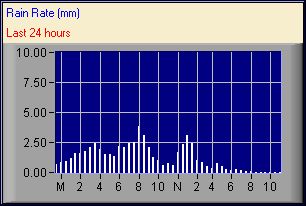 23
November 2003
23
November 2003
A
considerable amount of heavy rain fell continuously throughout the day,
stopping as darkness fell. By midnight the total was 27.69 mm (just over
an inch). This was the greatest amount of rainfall in a single day this
year and the heaviest since 10 August 2002.
On 22 November 2003
the rainfall total was 14.93 mm.
5 November
2003
The
water level gauge read 1 m 52 cm, a fall of 13 cm in six days.
3 November
2003
After
a couple of days of rainfall, I expected the lagoon to be more dilute.
Using
the same wide spectrum hydrometer used
for the other readings, the
specific gravity at the
meniscus
read 1.022 at 16° C. This gives a salinity
of about 30‰ (ppt).
However,
after deducting the hydrometer correction figure we arrive a salinity of
25‰ (ppt).
(I
am not happen about the accuracy of these hydrometer readings, so they
should be just a general guide.)
31
October 2003
 |
 |
 |
|
|
|
|
 After
nearly 25 mm of rain in the last three days and the high tides, Widewater
was in flood and the spit at the east end near the island was completely
under water. The height reading was 1 m 65 cm. This level was higher than
at any time this year. West Way, Lancing (at a lower level) was not flooded,
the rain water quickly drained away.
After
nearly 25 mm of rain in the last three days and the high tides, Widewater
was in flood and the spit at the east end near the island was completely
under water. The height reading was 1 m 65 cm. This level was higher than
at any time this year. West Way, Lancing (at a lower level) was not flooded,
the rain water quickly drained away.
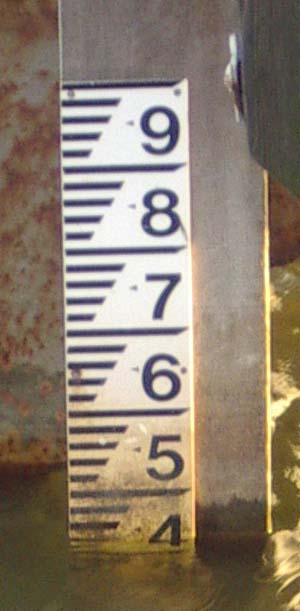 5
October 2003
5
October 2003
It
seems hardly worth taking the specific gravity (to
calculate salinity) readings as I expect again that the readings will be
identical to natural seawater.
The
water sample seemed clearer than previous ones (the water looks very orange
in the small bucket, but always looks clear in the glass.measuring chamber).
Using
the same wide spectrum hydrometer used
for the other readings, the
specific gravity at the
meniscus
read 1.029 at 13° C. Using the method before correction this would
give a salinity of 39‰.
However, after
deducting the hydrometer correction figure we arrive a salinity of 34‰
(ppt). The more reliable narrow spectrum
hydrometer gave a reading of 1.026 which actually would mean a saline figure
of 35‰.
It
is fairly clear that Widewater (at least in summer) is now a fully saline
lagoon.
2 October
2003
Despite
a small rain shower of just 3.54 mm, the lower high tides means the water
level of the lagoon has fallen fractionally, by 2.5 cm, since 30
September 2003. The has been a report of small
flood in West Way, Lancing, an event that is associated with high spring
tides.
30
September 2003
It
is surprising how full Widewater Lagoon can
look after just a small rise because of the percolation and sea rushing
through the inlet. The water spreads out over the flat flood plain, submerging
most of the Glasswort.
 |
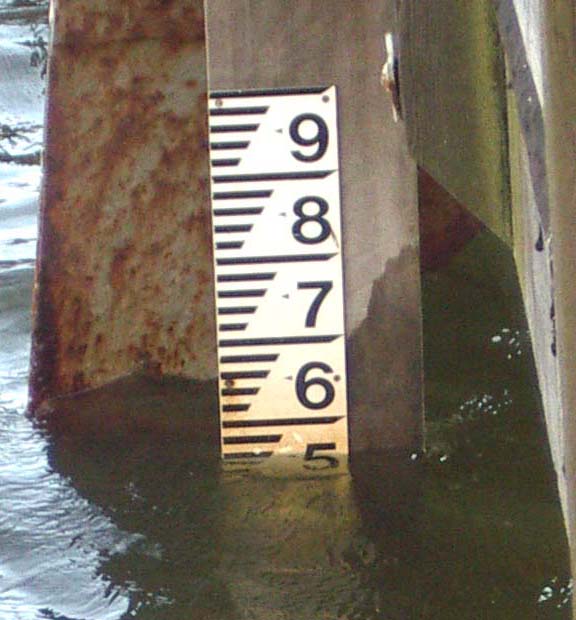 |
26-27
September 2003
The
inlet pipe to
Widewater
Lagoon has not been detrimental to the autumn Glasswort,
Salicornia,as
if anything the splendid and unusual scarlet fringe to the lagoon is even
more dramatic than usual. A large
Little
Egret was feeding to the west of the bridge.
The amount of water coming in was at a greater volume than I had seen before,
but this may be because it was at the peak of a high 6.5 metre equinoctial
spring tide. The lagoon water level is as high as I ever seen after a slight
fall of a few centimetres during the neap tides last week.
|
|
 |
|
|
|
8 September
2003
Despite
the huge influx of seawater through the pipeline, the water lagoon is still
orangey, which may (guessing) reflect a large amount of dissolved organic
carbon (DOC). The local residents are happy with the flooded lagoon and
as the smells (hydrogen sulphide) are gone and it looks more attractive
(arguable). The level of the lagoon is as high as I have ever seen it,
and as high as after exceptionally heavy rainfall in October
2000. The dissolved oxygen level was almost
certainly low in the summer so the lagoon does not mimic estuarine conditions
(e.g. if the Adur estuary was flooded their would be a dissolved oxygen
shortfall below limits which could support large or even small fish).
Comment:
Nobody
has written down the hydrology of Widewater Lagoon and the nearby water
table, at least not in the public domain. I am not sure if the amount of
water coming in and the salinity is being monitored by the authorities,
at least not publicly. The long term ecological and hydrological consequences
is their responsibility. The best the public can ask for is to make the
information public and pray that the Environmental Agency (in charge of
the pipeline) know what they are doing.
 |
 |
 |
Using the same wide spectrum hydrometer used for the other readings, the specific gravity at the meniscus read 1.028 at 22° C. Using the method before correction this would give a salinity of 40‰. However, after deducting the hydrometer correction figure we arrive a salinity of 35‰ (ppt), which is full strength seawater. The other hydrometer (calibrated at 15° C and verified accuracy with fresh seawater) gave a SG reading of 1.027, which would give a salinity of 37‰. Unfortunately, hydrometer readings are not really accurate enough for more than a general guide.
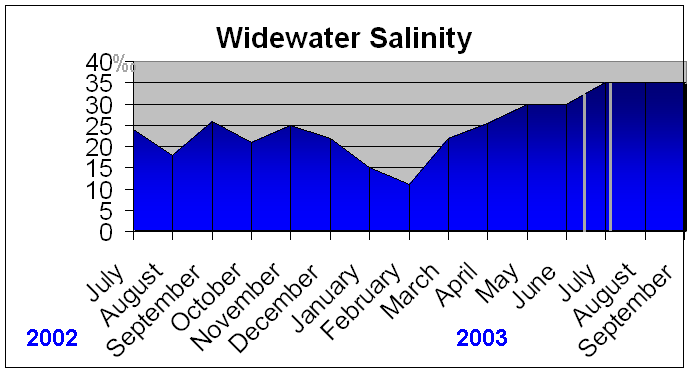
4 August
2003
The
level of Widewater Lagoon exceeded any observed level during the summer
and the lagoon was as high as it is at peak levels in February of each
year. This can be judged most clearly by the water coming over the wooden
slats near the bridge. This will extra water coming in through the pipe
and some much seawater has been allowed in, I would feel fairly confident
to predict that the salinity will match that of the open sea, i.e. 35‰
or thereabouts. There seemed to be excessive sediment as well and broken
off bits of weed or plankton in the collection bucket.
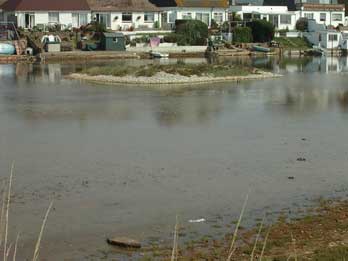 |
 |
Using the same wide spectrum hydrometer used for the other readings, the specific gravity at the meniscus read 1.026 at 24° C. Using the method before correction this would give a salinity of 38‰. However, after deducting the hydrometer correction figure we arrive a salinity of 33‰ (ppt). The more reliable narrow spectrum hydrometer gave a reading of 1.026 which actually could mean a hypersaline figure of 38‰. Unfortunately, hydrometer readings are not really accurate enough for more than a general guide. (The explanation in this case, is maybe the correction figure is wrong to adjust for the different calibration? I expect the calibration scale on the wide spectrum Taiwanese hydrometer is just wrong.)
18 July 2003
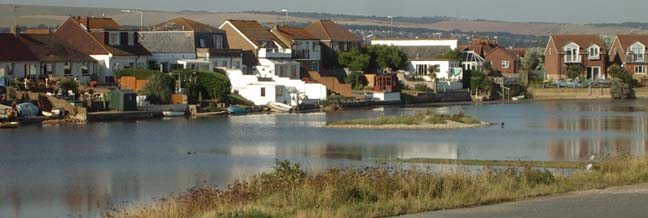
The combination of the high tides and the new inlet pipe have resulted in Widewater Lagoon being in flood comparable to winter. The flood plain wild flowers (weeds) are under threat from the saline conditions, possibly including the Sea Heath, Frankenia laevis.
16
July 2003
The
pipeline is still open and the lagoon level has risen considerably after
the recent high spring tides (in excess of six metres). With evaporation
in the recent excessively hot weather,
I would anticipate that the salinity can only have risen above that of
in the sea. However, as I have never recorded salinities in excess of sea
water in Widewater Lagoon, there may be a reservoir
of water under the lagoon which maintains a maximum level of 35‰ or thereabouts
even when the lagoon dries out, i.e. it does not necessarily go hypersaline.
Pupils from St. Andrew's School, Worthing, were collecting lagoon critters in the rain.
High tide occurred about 2:00 pm and I have never seen so many bubbles going up through the bottom of the lagoon for almost its whole length. Furthermore, the sea was gushing in through the pipeline. According to Derek Neate (FOWL), four slats have been lifted off the inlet pipe.
Using the same wide spectrum hydrometer used for the other readings, the specific gravity at the meniscus read 1.026 at 22° C. Using the method before correction this would give a salinity of 37.5‰. However, after deducting the hydrometer correction figure we arrive a salinity of 32.5‰ (ppt). The narrow spectrum hydrometer (calibrated at 15° C) recorded 1.025 (a small fall) which translates to 35‰ (ppt).
As I was beginning to suspect, the salinity in the lagoon does not actually rise above that of fresh seawater, as none of my readings in the past have exceeded 35‰ (ppt).
Where does the water go when it leaves through the lagoon floor? Does it go back out to sea? It would be ironic if it actually builds up the water table in the Hasler Estate (to the north and below sea level) as the whole sea defence plan was to prevent winter floods.
There
is also the impact of the high lagoon levels on the wild flowers of the
lagoon
flood plain to consider.
10 July 2003
The mud was very soft in a metre band on the lagoon's southern edge.
4 July
2003
|
Birdwatching
in all months of the year
Dog
exercise area, with faeces remaining
Cycling:
important route from Shoreham
to Worthing (marked on OS map)
Minority interests:
Botanical interest in shingle and some unusual and rare plants
4 July
2003
Afternoon
It
looks like that far more sea water is being allowed in through the pipe
than was ever percolated through the shingle, and the salinity figures
seem to indicate this.
 |
 |
|
|
Despite the regular updates with fresh sea water, on a humid 70% and overcast day, temp. 21° C, wind force 4, the photograph shows an area of wet mud. This is not evaporation. There is there a leak in the bottom of the lagoon where the water runs out through the cracked alluvium/clay after a dry spell. |
Surprisingly
a
fall in salinity was detected today. Using the same wide spectrum hydrometer
used for the other readings, the
specific gravity
at the
meniscus read 1.026 at 22° C.
Using the method before correction this would give a salinity of 37.5‰.
However,
after deducting the hydrometer correction figure we arrive a salinity of
32.5‰ (ppt). The narrow spectrum
hydrometer (calibrated at 15° C) recorded 1.025 (a small fall) which
translates to 35‰ (ppt).
 |
 |
A very cleverly designed inlet pipe that would foil anything but the most adventurous Shore Crab
The lagoon may not be going hypersaline. There may be a reservoir underneath the lagoon? (This will contain seawater at 35‰ in low rainfall times, and it is leakage rather than evaporation that is causing the fall in water during the summer. In the past, in five years measurements during the 1980s, I never recorded any salinity readings in excess of full strength seawater and virtually all summer salinities were in the brackish range, i.e. under 30‰.)
Morning
Another
appreciable rise has been caused by the pipeline being left open on the
medium spring tides, which will cause the water in Widewater Lagoon becoming
too saline to support aquatic life if it continues at this rate of increase.
The water level rise can be compared in the photographs below. This is caused by the input of seawater, not by rainfall.
2 July
2003
I
got caught in a rainfall deluge and there was intermittent showers and
early morning rain since the photograph yesterday. By midday the rain had
caused the level of the lagoon to rise as shown in the following photograph:
The level was still not as high as on 11 June 2003. The rainfall according to the for the period both between the two photographs and the two specific gravity readings was 12.19 mm (precise figures available). I would estimate that the lagoon level has risen by about this amount which is rather convenient (but, perhaps, not surprising) and expected.
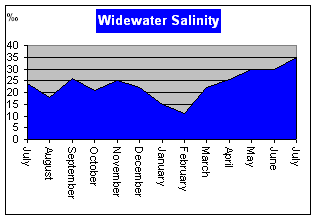
|
1
July 2003
The
Environmental
Agency opened up the four inch slats and three workers (in two vehicles)
supervised the the input of seawater into Widewater
Lagoon on the high spring tide. Despite this topping up the lagoon
(are the figures available for the amount of water?), the water level was
still fractionally down compared to
11 June
2003. The two photographs can be compared:
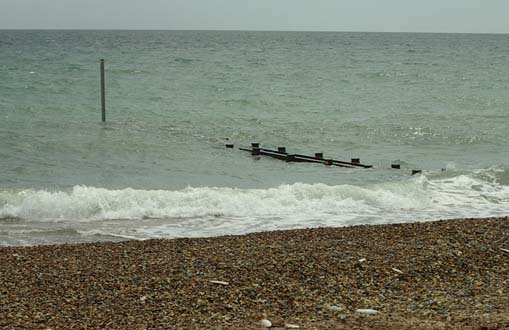 |
 |
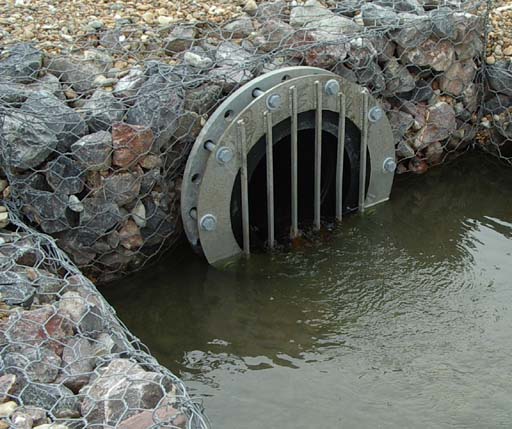 |
|
One hundred cuttlebones decorated the strandline |
|
|
Small prawns, Palaemon elegans, were being swept over the weir into the lagoon, but there were not other visible animals introduced.
Although
it was nearly two weeks ahead of schedule, I collected an extra water sample
from the usual place by the bridge.
Using
the same wide spectrum hydrometer used
for the other readings, the
specific gravity at the
meniscus
read 1.028 at 22° C. Using the method before correction this would
give a salinity of 40‰. However, after
deducting the hydrometer correction figure we arrive a salinity of 35‰
(ppt), which is full strength seawater. This
was such an alarming rise that I checked it with my other narrow range
hydrometer which gave a reading of 1.026, and this hydrometer was calibrated
at 15° C, which would give a salinity of 36‰ (ppt). The
lagoon is going hypersaline.
The
Project Manager at the Environmental
Agency is Stuart Meakins. (Tel:
01903 832000)
At the meeting with Peter Midgely and the Environment Agency and Tim Loughton MP it was agreed that the pipeline would only be put into operation when the tide levels exceeded six metres which would thought to mimic natural conditions.
Anyrate, the Widewater Management Group have now had an Extraordinary General Meeting to get the levels reduced to a lesser figure, at least 5.7 metres which is thousands, probably millions of gallons of extra salty water, which has already turned the lagoon as salty as the English Channel. The grounds for this is that the lagoon levels were getting too low.
14
June 2003
Stuart
Meakins (Environmental Agency) advises me that this was the date the pipeline
was first put into operation (by telephone
conversation of 3 July 2003). This is a Saturday
with a high spring tide of 6.4 metres (WXTides).
The
pipeline was actually opened on 13 June 2003
at
8:00 pm by the FOWL Pipeline Management Team. However, as this was only
at half spring tide of 3 metres at this hour, I assume that the water would
not come through until 10:30 pm when the tide reached 6 metres in height.
11
June 2003
Despite
the recent rain, the level of the lagoon was about 50 mm lower than May
and this leaves bare patches of mud.
Using the same wide spectrum hydrometer used for the other readings, the specific gravity at the meniscus read 1.025 at 22° C. Using the method before correction this would give a salinity of 35‰. However, after deducting the hydrometer correction figure we arrive a salinity of 30‰ (ppt).
Despite
the fall in water, the salinity remains the same comparatively high figure.
11
May 2003
April
and early may were exceptionally dry with hardly any rain. It is inconceivable
that the salinity should fall although the water level remained constant,
so I would expect little change from last month.
Using
the same wide spectrum hydrometer used
for the other readings, the
specific gravity at the
meniscus
read 1.026 at 16° C. Using the method before correction this would
give a salinity of 35‰. However, after
deducting the hydrometer correction figure we arrive a salinity of 30‰
(ppt).
This
is the highest recorded salinity in the last year. Is fresh seawater being
allowed through the pipeline into the lagoon to maintain a high level?
8 April
2003
There
has been hardly any rainfall in the last month and the pipeline is now
installed (although I do not know if it has been letting any sea water
in) so it is not expected that the reading will show a dilution of the
lagoon water. There has been a negligible fall in the water level since
last month.
Using the same wide spectrum hydrometer used for the other readings, the specific gravity at the meniscus read 1.023 at 12° C. Using the method before correction this would give a salinity of 30.5‰. However, after deducting the hydrometer correction figure we arrive a salinity of 25.5‰ (ppt). This reading is almost up to the maximum figure recorded last year.
6
March 2003
After
a month of very little rainfall, I would guess that the salinity fall would
not be maintained, and perhaps a rise from the minimum figure. The
lagoon is heavily in flood and this is usually associated with heavy rainfall.
Using
the same wide spectrum hydrometer used
for the other readings, the
specific gravity at the
meniscus
read 1.020 at 11° C. Using the method before correction this would
give a salinity of 27‰. However, after
deducting the hydrometer correction figure we arrive a salinity of 22‰
(ppt). This
reading
represents the largest monthly rise in salinity for a whole year. I
have now (3 July
2003) been advised
that the pipeline was not in operation at this date. In the middle of February,
there were certainly some very large spring tides.
The only
conclusion to draw is that there must have been a massive (unprecedented)
amount of seawater percolating through the shingle.
10
February 2003
It
is in this month I would forecast the minimum salinity.
Using
the same wide spectrum hydrometer used
for the other readings, the
specific gravity at the
meniscus
read 1.012 at 10° C. Using the method before correction this would
give a salinity of 16‰. However,
after deducting the hydrometer correction figure we arrive a salinity of
11‰ (ppt).
4 January
2003
After
a period of rainfall up to a maximum of 13 mm a day, not that much, but
enough to cause a few minor floods, Widewater Lagoon has risen a few centimetres
and the whole lagoon flood plain is flooded at the east end. I would estimate
fall in salinity of about 5‰ and 8‰.
Using
the same wide spectrum hydrometer used
for the other readings, the
specific gravity at the
meniscus
read 1.016 at 7° C. Using the method before correction this would give
a salinity of 20‰. However, after
deducting the hydrometer correction figure we arrive a salinity of 15‰
(ppt). This is a fall of 7‰ from 15 days
ago.
20
December 2002
The
lagoon water had risen at most an inch since last month.
Using the same wide spectrum hydrometer
used for the other readings, the
specific gravity
at the meniscus read 1.020 at 8° C. Using
the method before correction this would give a salinity of 27‰. This is
the same as last month. However, after
deducting the hydrometer correction figure we arrive a salinity of 22‰
(ppt).
17
November 2002
There
has been a considerable amount of rain and Widewater
Lagoon was flooded but not all that much more, but enough for me to
estimate a salinity of 21‰ (ppt). Using the
same wide spectrum hydrometer used for
the other readings, the
specific gravity at the meniscus
read 1.020 at 10° C. Using the method before correction this would
give a salinity of 27‰. However, after
deducting the hydrometer correction figure we arrive a salinity of 22‰
(ppt).
3 November
2002
After
a couple of days of rainfall, I expected the lagoon to be more dilute.
Using
the same wide spectrum hydrometer used
for the other readings, the
specific gravity at the
meniscus
read 1.022 at 15° C. This gives a salinity
of about 30‰ (ppt).
Alas,
I suddenly had doubts about the accuracy of the calibration in this Taiwan
made instrument. I decided to take the measurement using the old smaller
spectrum tropical aquarium hydrometer and this gave a reading of 1.018,
which would gave a salinity of about 25‰ (ppt)
(which really is a large difference). I will check the readings with real
seawater. (The tropical aquarium hydrometer has a lowest reading of 1.018,
which is why it was not used before.)
The
small pawns were absent on the edge of the lagoon.
Salinity
corrected to 25‰ (ppt)
NOTE: the manufacturers have probably calibrated the hydrometer at about 23° C to 28° C and I will have to adjust all the salinity readings.
7 October
2002
After
a month of minimal rain and with an Indian
Summer summer preceding some of the highest and lowest equinoctial
spring tides for over 20 years, I visited Widewater
Lagoon, 1½ hours after the midday high spring tide of 6.8 metres.
The bubbles of percolating seawater had ceased by then and the only water
commotion was caused by a small flock of Ringed
Plover. There was a band of about 40 cm
of wet mud (west of the bridge) where it looked as though the water had
recently receded. The lagoon level was higher than that of a month ago,
as the separate westerly lagoon was a continuous sheet of water, but still
scarcely more than a large puddle. The air
temperature was recorded at 21° C and water temperature in the lagoon
at 16.5° C. The specific gravity reading in the
main channel was about 1.018 at 20° C (accurate home laboratory testing)
which gives a salinity of about 26‰ (ppt)
which is into the brackish range that could support cockles and other marine
organisms.
There were thousands of small prawns
in the lagoon.
Salinity
corrected to 21‰ (ppt)
4 September
2002
After
a dry spell, Widewater Lagoon had receded/dried/leaked out and the small
separate
lagoon west of the western causeway was reduced to a few puddles since
14
August 2002. A live Lagoon
Cockle was found on the surface.
The
specific
gravity reading in the main channel was about 1.022 at 21° C which
gives a salinity of about 31‰ (ppt)
which is above brackish water into the seawater range. Full strength seawater
is 34‰ (ppt).
Salinity
corrected to 26‰ (ppt).
14
August 2002
Widewater
Lagoon was very full of water for August
which
could be explained by the heavy rainfall of the last few days which caused
flooding in some places. The high tide of
6.1 metres (WXTide Table)
occurred at 4.27 pm BST and
the air bubbles shooting up through the cracks in the alluvium floor of
the lagoon began one hour before the high tide. They occurred as a steady
stream of small bubbles and sometimes as large less frequent bubbles and
these bubble points occurred more often in the shallow water but also could
be seen at the surface in water that was two metres deep. The conjecture
is that this is seawater being forced into the lagoon through the shingle
bank and the bubbling only occurs on tides of over 6 metres in height.
At
3.10
pm I saw some air bubbles in the area approx.
200 metres west of main ridge and spreading a further 100 metres west.
There must have been at least 100 sets of bubbles! At least six had water
rising at least 25 mm over the level of the Widewater. At this time there
were no other areas showing this effect.
At
5.00
pm I then witnessed the same again this time
some 200 metres east of the bridge and extending another 50 metres east.
The bubble form was less pronounced than the previous lot.
10
August 2002
The
rainfall for the day totalled 34.6 mm.
Recent
Historical Records
7 July
2002
The
trip in the unseasonal drizzle to Widewater Lagoon,
ostensibly in the search for the sea anemone Edwardsia
ivelli, but actually the collection of anaerobic mud and hundreds
of dead shells of the Lagoon Cockle, Cerastoderma
glaucum, with just the remotest long
shot that something interesting would creep out.The
specific
gravity reading in the main channel was about 1.021 at 16° C which
gives a salinity of about 29‰ (ppt)
which is into the high brackish range that could support cockles and other
marine organisms.
Salinity
corrected to 24‰ (ppt).
Notes:
Salinity readings for Widewater using a hydrometer where measured each
year during the summer, usually July, in 1981, 1982, and in 1986,
1987, 1988, and all these readings were below full strength sea water.
Readings were taken in the main body of the lagoon and all the readings
on the same day were exactly the same, at different locations in the lagoon
water.
| The Fleet: Gore Cove | SY 615 807 |
| Studland (Purbeck): Little Sea | SZ 030 843 |
| Gillkicker Point | SZ 608 977 |
| Cockle Ponds, Gosport | SZ 618 996 |
| Moat, Gosport | SZ 618 996 |
| Hilsea Lines: West Moat | SU 668 041 |
| Hilsea Lines: East Moat | SU 653 045 |
| Mill Pond: Emsworth | SU 748 053 |
| Slipper Pond: Emsworth | SU 753 056 |
| Birdham Lake | SU 826 008 |
| Pagham Harbour | |
| Littlehampton (Pond) | SZ 028 015 |
| Widewater | |
| Cuckmere River Estuary | TY 518 993 |